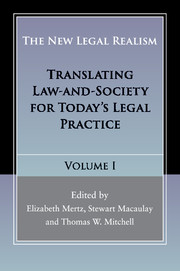Book contents
- Frontmatter
- Contents
- List of contributors
- Preface to The New Legal Realism, Volumes I and II
- 1 Introduction: New Legal Realism: Law and Social Science in the New Millennium
- Section I THE PLACE OF NEW LEGAL REALISM IN LEGAL THOUGHT AND TEACHING
- 2 A New Legal Realism: Elegant Models and the Messy Law in Action
- 3 Putting the “Real World” into Traditional Classroom Teaching
- 4 Some Realism about Realism in Teaching about the Legal Profession
- 5 “Fielding” Legal Realism: Law Students as Participant-Observers?
- Section II PHILOSOPHY AND METHODS FOR A NEW LEGAL REALISM
- Section III NEW LEGAL REALIST TRANSLATIONS
- Index
- References
3 - Putting the “Real World” into Traditional Classroom Teaching
from Section I - THE PLACE OF NEW LEGAL REALISM IN LEGAL THOUGHT AND TEACHING
Published online by Cambridge University Press: 05 May 2016
- Frontmatter
- Contents
- List of contributors
- Preface to The New Legal Realism, Volumes I and II
- 1 Introduction: New Legal Realism: Law and Social Science in the New Millennium
- Section I THE PLACE OF NEW LEGAL REALISM IN LEGAL THOUGHT AND TEACHING
- 2 A New Legal Realism: Elegant Models and the Messy Law in Action
- 3 Putting the “Real World” into Traditional Classroom Teaching
- 4 Some Realism about Realism in Teaching about the Legal Profession
- 5 “Fielding” Legal Realism: Law Students as Participant-Observers?
- Section II PHILOSOPHY AND METHODS FOR A NEW LEGAL REALISM
- Section III NEW LEGAL REALIST TRANSLATIONS
- Index
- References
Summary
We begin this essay by situating ourselves within legal academia. We are law professors, and as part of our work we teach. We have taught traditional classes designed around doctrinal categories, classes usually based on materials heavily dominated by appellate cases. We are also clinical teachers with distinctive methods for teaching students about law and lawyering as they practice law under our supervision. We are attentive to what justice means and how power operates throughout the legal system as students assume the role of lawyer, take responsibility for clients, learn to act skillfully, encounter the complexity of their clients’ lives, interpret and reinterpret law and facts as they meld them into case theories, engage with legal and social institutions implicated in each legal matter, and confront the complex sociolegal world that forms the context of each student's client representation. Using our methodologies for teaching in the clinic seminar, rounds, and supervision, we self-consciously emphasize reflection about students’ shaping their professional identities (Sullivan, Colby, Wegner, Bond, and Shulman 2007) as they grapple with all aspects of the work of the lawyer (Bryant, Milstein, and Shalleck 2014). Our students are simultaneously participants in and observers of the part of the sociolegal world implicated in the matter they handle. We – and our students – experience daily the imperative of knowing and using both law on the ground and law in the books, as well as the shifting relationship between them. Often our students need to consult and use social science materials for understanding or pursuing the legal matters they handle. In our nonclinical teaching, we strive to make these same concerns part of learning that is based primarily in the classroom, recognizing that teaching and learning look and feel quite different when students are not active participants with responsibility for representing clients in the legal system. In this essay, we analyze a micro example – using exercises based on one problem in one class in one course – of how we try to bring into the classroom teaching about law on the ground as it relates to formal law.
New Legal Realism, just like old Legal Realism, has animated our work, both in and out of clinic. While this is not the occasion for a full exploration of the overlapping concerns, methods, and theoretical orientations of clinical thought and new legal realist thought, the projects intersect, reinforce, and reinvigorate each other.
- Type
- Chapter
- Information
- The New Legal RealismTranslating Law-and-Society for Today's Legal Practice, pp. 51 - 73Publisher: Cambridge University PressPrint publication year: 2016
References
- 2
- Cited by

